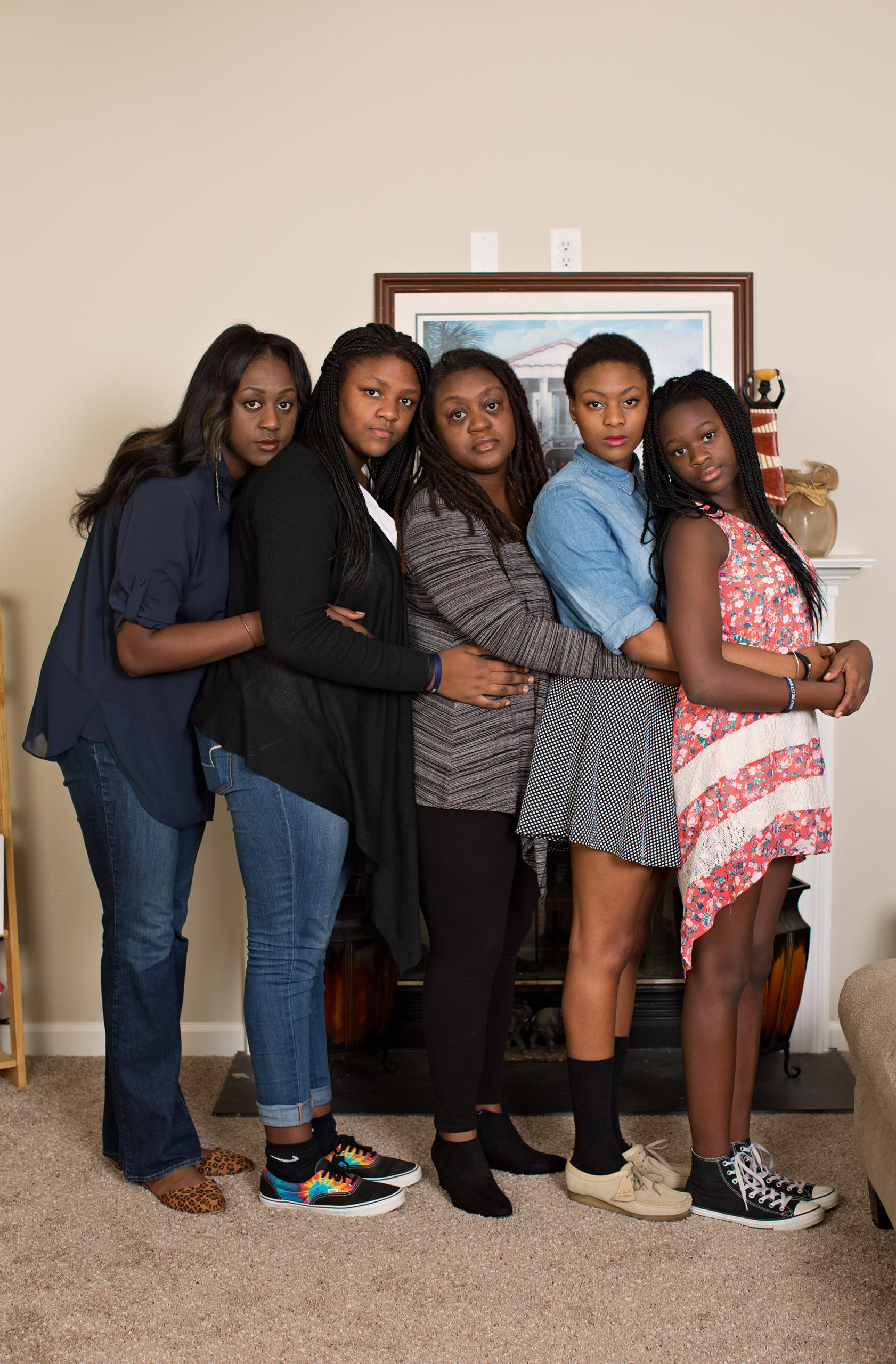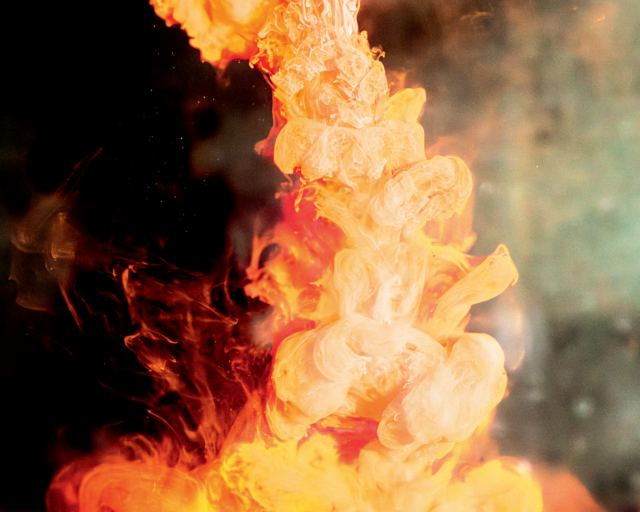Deana Lawson, Bethane Middleton-Brown with Gracyn, Hali, Kaylin, and Czana DePayne, 2015.
Courtesy the artist and Rhona Hoffman Gallery, Chicago
Nikki A. Greene: On June 17, 2015, the tragedy of the murders of nine African American members of the Emanuel African Methodist Episcopal Church in Charleston, South Carolina—Rev. Clementa Pinckney, Cynthia Graham Hurd, Ethel Lance, Rev. DePayne Middleton-Doctor, Tywanza Sanders, Myra Thompson, Sharonda Coleman-Singleton, Susie Jackson, and Rev. Daniel Simmons Sr.—became a peculiar terrorist act in the United States, primarily because it took place in a church during a Wednesday evening prayer meeting. For me, this kind of attack felt very similar to the bombing of the Sixteenth Street Baptist Church in Birmingham, Alabama, in 1963, particularly because of its violence within a black church. When you first heard about the attack in Charleston, what were some of your initial thoughts or reactions?
Deana Lawson: When I first heard about the attack, I felt an overwhelming anxiety about a continuum of violence occurring on black bodies in America. I thought about sanctuary spaces, both spiritual and domestic, within African American life, and how this act was such a violation of the sanctuary, a safe haven … a wild disrespect and madness rooted in racial fear. I also thought about the history of racial terror directed at African American personal and spiritual life from the transatlantic slave trade to the present day. I was reminded of the significance of the black church as a site of resistance to racial oppression and a space to promote African American power in the face of white fear.
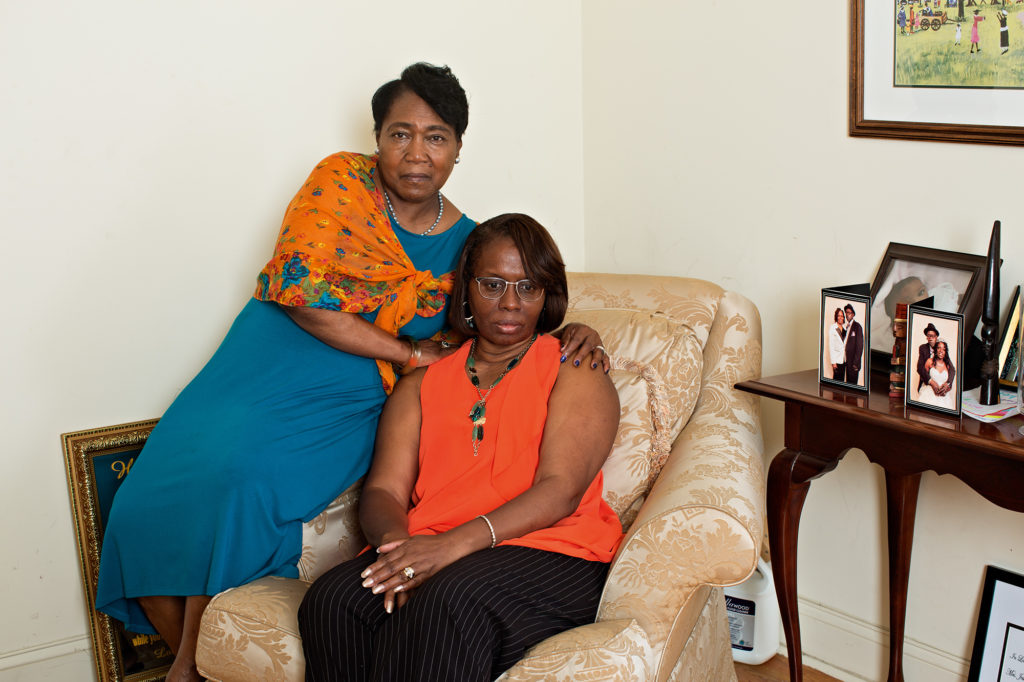
Greene: What did it mean for you to photograph as part of Time magazine’s series, “Telling Charleston’s Story in Photographs”? Did you have any preconceived notions about the ways that your photos would “perform” for that audience?
Lawson: Time is such a powerful magazine with a vast audience of over seventeen million readers. So, I was honored that the magazine considered my aesthetic and sensitivity as a photographer to be most appropriate for the Charleston story. I immediately accepted the commission because the complex narrative of violence, loss, and humanity related to themes in my larger body of work. Further, I felt personally connected, as an African American woman, to the Emanuel 9 story. My intention was to stay true to my overarching vision and make portraits that I felt would honor the deceased loved ones. If the victims were present, I would want them to be proud of the photographs that represented themselves and their families.

Greene: You are accustomed to photographing strangers in very specific locations: posing two nude strangers intimately within a lush background in the Democratic Republic of Congo or a woman in her kitchen in Detroit. For the Time commission, did you maintain the same kind of distance, since the lives of these families, or more precisely, the deaths of their loved ones, were so highly publicized? Did the distance in time between June and November, when the Time issue was published, help with creating some detachment, since much of their stories had receded from the limelight by then?
Lawson: The personal and psychological distance for the Time commission was unusual, in that I was given clear direction not to engage too much in talking about the story with the subjects because the reportage was highly confidential, and instead focus only on the photography. However, there were times when the subjects desired to talk and engage. Usually when we arrived at a subject’s house, they welcomed us like family and offered us food. I tried to exercise a balance of sensitivity, detachment, and engagement in order to make the pictures.
For example, Nadine Collier (the daughter of Ethel Lance), she has such a beautiful living room. We just went back to her bedroom to pick out the clothes that she would wear. I remember that her mother’s favorite color was royal blue. So we decided that she and her granddaughter, Najee, would wear blue for that picture. She showed us a picture of her mom that she had printed poster size, and as she was showing us the picture, she just broke down and started crying. I think that with my assistant and I, both of us being African American women, Nadine felt comfortable enough to show her emotions to us in that way. After the photo shoot, she offered us cake. She was really open, and it was a really great photograph.
One subject lost her son. Even though she didn’t cry in front of us, I could tell that she was definitely still dealing with it, the weight of that loss. When photographing her, my strobe lights made a “pop” sound when I took each picture. When we first began photographing, it actually scared her a bit. It reminded her of when the shooting took place, because she was one of the subjects who survived the shooting. So that shows how present and traumatic the incident still was in different people’s minds.
The passing of time is relative in both situations. The distance between June and November might seem like a lot, but it’s still quite fresh with regard to mourning, which can take years, and sometimes decades. The hurt and emotional weight of loss still felt very present.
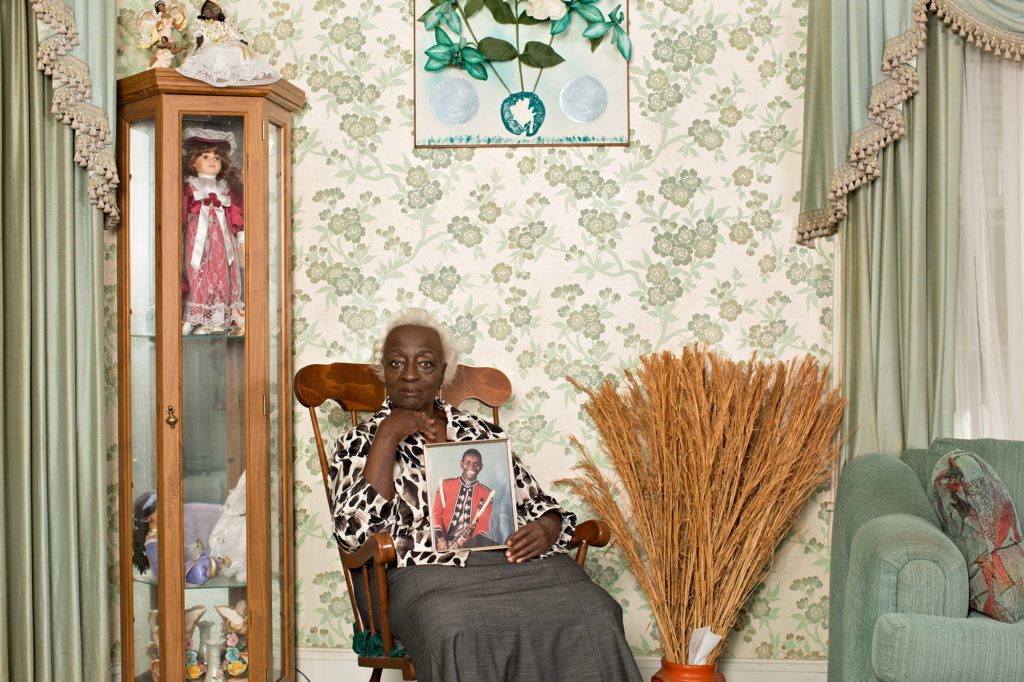
Greene: Also, many of the photographs really appear so southern (i.e., the curio cabinet in Gracie Broome’s Charleston home). Did you pick up on that as well, especially as a native northeasterner?
Lawson: Indeed, but still the décor felt familiar to me.
Greene: How so?
Lawson: The warm welcoming of us into their houses, but also just the domestic space. Many of the subjects’ homes reminded me of my family’s décor. Mother Broome’s home (Clementa Pinckney’s grandmother) had all the grandeur and warmth of a southern country home. The wallpaper, carpet, and mint green coloring welcomed us inside, along with Mother Broome’s quiet and regal spirit. Rarely do I see wallpaper in people’s houses today, even though I have wallpaper in my own apartment. There is also a similarity in class in terms of working class ways of decorating and adorning one’s home that felt familiar to me. The specific details of domestic spaces give visual dimension and texture towards the personal and emotional space of the Emanuel 9 families. The way that food was offered, and the overall hospitality, reminded me of growing up in church. The hospitality that the assailant, Dylann Roof, received from the church to welcome him into the Bible study was very much a metaphor for the warm welcome and spirit that we received from individuals as strangers from Time magazine photographing the subjects.
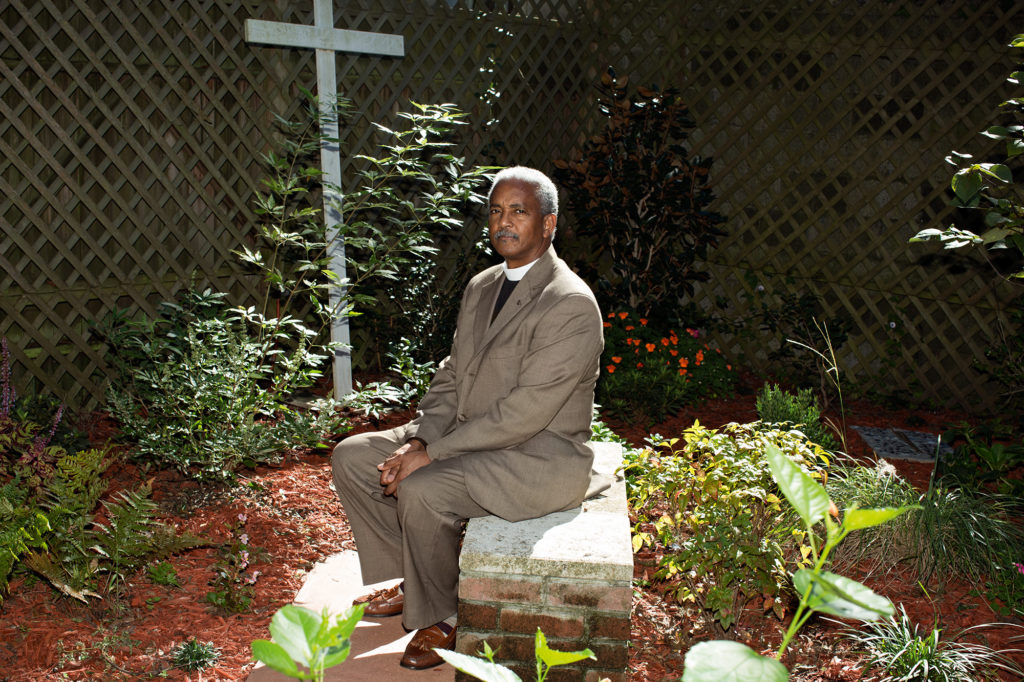
Greene: The focus of your work over the last decade has come to take on not simply international locations, including Haiti, Ethiopia, and the DR Congo, but also sacred sites, both real and imagined. How does the site of Mother Emanuel, the victims’ families’ homes, and perhaps Charleston, in general, fit now within the spectrum of your photography? Did you view the assignment in Charleston as one that also had a global perspective?
Lawson: While on assignment, my assistant and I were intrigued by the speech accent of Charleston African Americans, which we thought distinct from a general southern accent. We soon realized what we were hearing was a Geechee accent of Gullah culture, which traces its ancestral roots back to Angola, Sierra Leone, and other countries in West and Central Africa. Visiting the city of Charleston and some of its outlying towns inspired me to return to the city for my own body of work.
I have not gone back to Charleston yet. Usually when I work, I have a sense of where I want to travel, eventually, for an ongoing project related to the African Diaspora. There are certain commonalities, differences, and affinities that I want to capture in the body and in the space, spiritual aesthetics; I felt like that really shined through in Charleston. Also, when we had some down time, we would go to soul food restaurants to get some fried chicken. To see the people coming in and out of spaces—I just felt like there was something about Charleston. I definitely want to go back not only to Charleston, but also to the Gulluah Island. In Robert Farris Thompson’s book, Flash of the Spirit (1983), he talks about Kongo spirituality and the mighty Kongo Kingdom. He talked about how, for many of the slaves from Kongo, their first port of entry into the U.S. was Charleston! I listened to him lecture maybe a month after I did the Time magazine job. That was also the catalyst to revisit Charleston because, as you mentioned, I went to the DR Congo, too, as a part of my other work.
Greene: So, the photographic assignment brings you full circle in your work then?
Lawson: Exactly.

Greene: Although the photographs of the individual sitters are all deeply moving, the photograph of the annex leading to the room where the shooting took place is particularly haunting. How did you did you decide to photograph that room as opposed to the interior of the main sanctuary?
Lawson: Although I took many pictures of the exquisite sanctuary, its stained glass windows and mahogany pews covered with red velvet, the image of the annex reverberated differently to me. I felt it important to capture the area where bible study is held and where the incident occurred. The silence and emptiness of the space, as depicted in the photograph, betrays the knowledge of violent mayhem that occurred. A tension is created through presence and resonate absence. This space is where much of the church’s behind-the-scenes activities take place; the kitchen and office are located nearby. Meetings, dinners, and office duties are handled near this area. When visiting, it was apparent that the church members were diligently and eloquently working to move forward and carry on with the day-to-day duties of the church, even with the painful memory of June 17th embedded in its space.
Greene: On the one-year anniversary of the shootings, do you have any reflections on the recirculation of your photographs in Aperture’s “Vision & Justice” issue?
It’s pretty amazing to have a selection of these images reprinted on a different platform in Aperture. Something happens when you have a photo story, and you have images with text. With Aperture, in addition to the article that Thomas J. Lax wrote for the issue, the way that the pictures are laid out, and even the picture of Mother Broome as the last spread of the magazine, honors the subjects’ families in a different way that essentially comes down to that harsh truth of what happened on June 17th. It is a story that we need to remember, just as we need to remember Denmark Vessey’s planned insurrection and the history of the founding of that particular AME church in Charleston.
I don’t know if the subjects will ever see this reprint in Aperture. I think the families would be really proud to know that their stories are being written about again, not only in the world of news reportage, but also in fine art photography.
Read more from “Vision & Justice” or subscribe to Aperture and never miss an issue.










